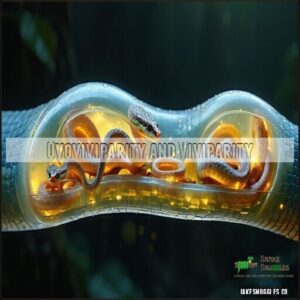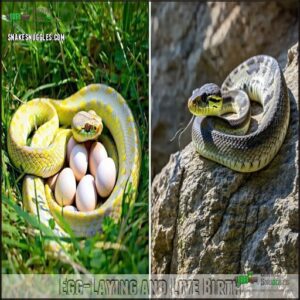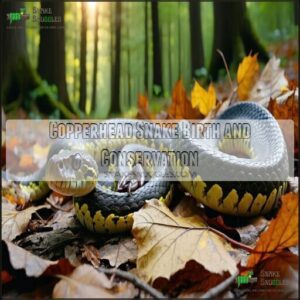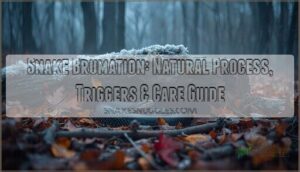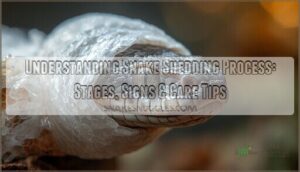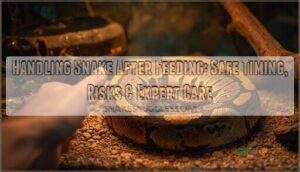This site is supported by our readers. We may earn a commission, at no cost to you, if you purchase through links.
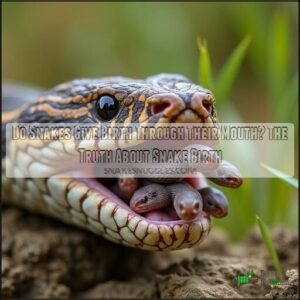
Snakes actually reproduce in one of two ways: laying eggs (oviparous) or giving birth to live young (viviparous).
Both methods involve the snake’s cloaca, a specialized opening at the base of their tail.
While some snakes might carry eggs in their body until they’re nearly developed, they’ll never expel offspring through their mouths.
The confusion likely stems from observations of snakes regurgitating large prey or defensive behaviors.
Understanding snake reproduction reveals fascinating adaptations that have helped these remarkable reptiles thrive for millions of years, and it is a part of reptile biology.
Table Of Contents
- Key Takeaways
- Do Snakes Give Birth Through Mouth?
- Snake Birth Methods Explained
- Snake Parental Care and Behavior
- Copperhead Snake Birth and Conservation
- Snake Reproduction and Mating Habits
- Identifying Venomous and Non-Venomous Snakes
- Snake Social Structure and Habitat
- Snake Enemies and Defense Mechanisms
- Rare and Endangered Snake Species
- Interesting Facts About Snakes
- Frequently Asked Questions (FAQs)
- Do snakes give birth through their mouths?
- Do snakes give birth oviparous or viviparous?
- Do snakes lay eggs through their mouths?
- How do snakes reproduce?
- Why do snakes carry their young in their mouths?
- Do snakes give birth or lay eggs?
- How Long Does It Take for a Snake to Give Birth?
- Do Snakes Experience Pain During the Birthing Process?
- How Many Babies Do Snakes Usually Have?
- How Does a Snake Care for Its Babies?
- Conclusion
Key Takeaways
- Snakes don’t give birth through their mouths—they use a specialized opening called the cloaca located at the base of their tail for both reproduction and waste elimination.
- You’ll find snakes reproduce in one of three ways: laying eggs (oviparous), giving live birth (viviparous), or retaining eggs inside until they hatch before birth (ovoviviparous).
- When you see a mother snake with babies in her mouth, she’s not giving birth but exhibiting protective behavior—carrying her young to safety from predators.
- Your understanding of snake reproduction can help dispel persistent myths and contribute to conservation efforts for these remarkable reptiles, which face threats from habitat loss and human persecution.
Do Snakes Give Birth Through Mouth?
Snakes don’t give birth through their mouths, despite what some myths suggest.
Instead, they use a specialized opening called the cloaca, located under their tail, to deliver eggs or live young.
Separating Fact From Fiction
The belief that snakes give birth through their mouths is one of the most enduring snake reproduction myths, but it’s far from true.
When you see snakes near their mother’s mouth, it’s likely protective behavior, not birth. Let’s set the record straight by tackling key snake misconceptions:
- Snakes don’t deliver babies through their mouths.
- Mouth movement during birth is unrelated to delivering young.
- Snakes reproduce differently depending on their species.
Scientifically, all snakes give birth or lay eggs through their cloaca function, an opening under their tail that doubles as a birth canal. The snake mouth birth myth arose from cultural misunderstandings or viral videos.
In reality, snake reproductive biology involves the cloaca—used for mating, birthing, and waste elimination. Proper education debunks myths and illuminates fascinating aspects of snake anatomy and reproduction.
Snake Reproductive Biology
Snakes may seem mysterious, but their reproductive biology is both practical and fascinating. Forget those snake reproduction myths—snakes don’t give birth through their mouths. Instead, reproduction happens through the cloaca, a multi-purpose opening for reproduction and waste removal.
You’ll find three reproductive strategies in snakes, each suited to their environment:
- Oviparous: Eggs are laid in safe spots like hollow logs or burrows, with about 70% of snakes choosing this method.
- Viviparous: Embryos develop inside the mother, nourished by a placenta-like structure, and are born live.
- Ovoviviparous: Eggs hatch within the mother before live young are born.
Snake mating involves males using hemipenes for fertilization, after which females carry developing embryos for weeks or months. From the flexible cloaca function to unique evolutionary adaptations, snakes guarantee their offspring’s survival even in challenging environments. The snake birthing process is nothing short of ingenious!
Common Misconceptions About Snake Birth
Misconceptions about snake birth can lead to some wild ideas, and one of the biggest myths is that they give birth through their mouths.
They don’t. Snake reproduction happens through the cloaca, an opening at the base of the tail.
Viral misinformation often confuses protective carrying (when snakes hold young in their mouths) with oral gestation.
| Myth Type | Explanation |
|---|---|
| Cloaca Function | Used for reproduction, not the mouth |
| Oral Gestation | A myth; no snakes give birth this way |
| Protective Carrying | Observed in some species for safety |
| Cultural Myths | Stemming from a lack of anatomical knowledge |
| Viral Misinformation | Fake videos showing snakes “spitting” eggs |
Snake Birth Methods Explained
Snakes use three fascinating methods to bring their young into the world: egg-laying, live birth, and a combination of both.
Each method is unique, shaped by the species and its environment, but none involve the mouth, using three fascinating methods.
Ovoviviparity and Viviparity
Forget the myths—snake reproduction is even more fascinating when you explore ovoviviparity and viviparity.
Ovoviviparous snakes, like rattlesnakes, are "livebearing snakes" that keep eggs inside their bodies until they hatch. Meanwhile, viviparous snakes, such as anacondas, nourish their young through placental nourishment, like mammals.
Here’s why these snake birth methods are so incredible:
- Internal Hatching: Eggs hatch safely within the mother, giving the young extra protection.
- Placental Nourishment Advantage: Viviparous snakes provide direct sustenance for growing embryos.
- Climate Adaptation: These methods allow reproduction in cold or harsh conditions.
- Evolutionary Origins: They showcase how snake reproduction evolved to guarantee survival.
Ovoviviparous and viviparous snakes excel at adapting to life’s extremes.
Egg-Laying and Live Birth
A snake’s reproductive journey is as fascinating as it’s diverse, with egg-laying and live birth showcasing nature’s adaptability. All snakes reproduce through the cloaca, ensuring their young are born or laid with precision to thrive.
- Oviparity Explained: Egg-laying snakes, like cobras, deposit leathery eggs in warm, hidden nests, relying on the environment for development.
- Viviparity Factors: Livebearing snakes, such as boas, evolved this method to endure colder climates, nourishing young through placenta-like structures.
- Egg Development: Ovoviviparous species balance both methods, hatching eggs inside before live birth.
You’ll find these snake birth methods beautifully adapted to their habitat. Egglaying snakes thrive in warm climates where heat incubates eggs, while livebearing snakes dominate cooler regions, maintaining temperature control.
The majority of snake species, about 70%, exhibit oviparous reproduction.
The remarkable variety of snake reproduction highlights nature’s ingenuity, from egg development to live birth, ensuring survival through countless environmental challenges.
Examples of Different Snake Species
Across the world, snake species use unique reproductive strategies adapted to their habitats.
Understanding these variations reveals nature’s creativity.
| Snake Type | Birth Method | Typical Habitat |
|---|---|---|
| Garter Snakes | Viviparous (live birth) | Meadows, woodlands |
| Pythons | Oviparous (egg-laying) | Tropical forests |
| Boa Constrictors | Ovoviviparous | Rainforests, deserts |
| Sea Snakes | Viviparous | Ocean waters |
| Anacondas | Viviparous | Swamps, wetlands |
These reproductive adaptations illustrate how a snake’s birth method matches its habitat, whether it’s garter snakes thriving in meadows or sea snakes adapting to ocean life.
Importantly, all reproduction happens through the cloaca, not the mouth.
This reinforces how every species navigates reproduction within its unique ecological niche.
Snake Parental Care and Behavior
You might think snakes don’t care for their young, but some show surprising parental behaviors.
From guarding eggs to staying with hatchlings, these actions help guarantee the survival of their offspring.
Diverse Range of Parental Care
While not known for affectionate parenting, snakes exhibit surprising diversity in how they care for their young.
Snake parental care includes both active and passive strategies, depending on the species and reproduction method.
- King cobras showcase unparalleled nest building, creating vegetation chambers they fiercely guard until the eggs hatch.
- Female pythons display egg guarding, coiling around their clutches to regulate warmth and humidity, ensuring ideal embryo development.
- Vipers, often seen as solitary, exhibit post-hatching care by staying close to their vulnerable offspring, even skipping meals for their safety.
- Some species protect hatchlings by carrying them in their mouths—mistaken as "mouth birth" but really parental investment.
- Other snakes, especially oviparous ones, leave their snake offspring to survive independently after reproduction.
These examples highlight that snake reproduction provides fascinating insights into their behavior, much deeper than myths suggest.
Nesting and Egg-Guarding Behaviors
In terms of snake reproduction, some species impress with their intricate nesting and egg-guarding behaviors. Far from the common myth of snakes giving birth through their mouths, most oviparous snakes rely on their maternal instincts to guarantee their offspring’s survival.
Certain species invest heavily in nest construction and temperature regulation. Python mothers, for instance, coil tightly around their eggs, using muscle contractions to generate heat and maintain stable incubation conditions. This often means fasting for weeks to protect their clutch. Meanwhile, king cobras build complex nests using leaves and debris, fiercely defending their territory.
Other snakes, like rat snakes, opt for a more concealed approach, hiding their eggs under logs or in burrows to minimize risks of abandonment. For those needing assistance maintaining proper temperatures, consider using a reptile egg incubator.
- Nest construction enhances clutch survival.
- Parental defense ensures safety against predators.
- Temperature regulation is critical for successful hatching.
Snake maternal care is far more sophisticated than one might expect.
Post-Hatching Care and Protection
After hatching, snake babies are often left to survive on their own, but some species provide brief yet essential parental care.
King cobras, for instance, fiercely guard their nests and hatchlings, substantially boosting hatchling survival rates by deterring predators. Pythons take it further, coiling around eggs to incubate them and sticking around even after they hatch, ensuring the snake young are safe during vulnerable moments like their first shedding.
Interestingly, ovoviviparous snakes like copperheads show fleeting maternal instincts, safeguarding snake babies as they navigate initial feeding and predator avoidance.
While parental absence impacts most snake species, these rare acts of snake maternal care enhance survival odds. Contrary to myths, snake mouth protection plays no role in caring for their young.
Copperhead Snake Birth and Conservation
Copperhead snakes give birth through a fascinating method called ovoviviparity, where eggs develop inside the mother and hatch just before live young are born.
Protecting their habitats and supporting conservation efforts are essential, as these snakes face environmental threats in various regions, including parts of Massachusetts, which is a critical aspect of their conservation.
Endangered Species in Massachusetts
Massachusetts is home to fascinating yet fragile wildlife, including the rare copperhead snake.
Sadly, habitat loss and climate change threaten their survival. These venomous predators play a big role in maintaining balance by controlling rodent populations and reflecting ecosystem health.
With only an estimated 150-200 copperheads left statewide, conservation strategies are critical.
Key conservation efforts include:
- Protecting habitats from development and invasive species
- Promoting public awareness about their importance
- Monitoring populations to guide protections
- Reducing human-snake conflicts through education
- Improving biodiversity to strengthen ecosystems
Your support for these conservation strategies can save these reptiles from extinction.
Copperhead Habitat and Distribution
From Florida’s panhandle to Massachusetts, copperhead snakes showcase remarkable habitat variation. Their geographic range includes forests, rocky slopes, wetlands, and even suburban outskirts, adapting seamlessly to different environments.
In northeastern regions, regional populations face challenges due to habitat loss and declining genetic diversity. Winter triggers communal denning, where multiple snakes hibernate together—an example of their fascinating snake behavior.
Seasonal shifts and temperature changes influence their movement, emphasizing the importance of understanding snake habitat needs. Protecting these venomous snakes through habitat conservation is essential, as human impact disrupts their ecosystems and endangers this unique part of snake biology.
Supporting Conservation Efforts
Now that we’ve examined where copperheads live, let’s look at how you can protect these remarkable creatures.
Copperhead populations benefit tremendously from your involvement in conservation efforts. Here’s how you can make a difference:
- Join habitat preservation initiatives that remove invasive plants threatening natural ecosystems
- Support anti-poaching measures by reporting suspicious activities to wildlife authorities
- Participate in education programs that correct misconceptions about snake reproductive biology
- Engage your community through volunteer snake monitoring projects
- Practice sustainable hiking habits by staying on designated trails in known snake habitats
Your actions guarantee these misunderstood reptiles can continue their natural reproductive cycles undisturbed. Remember, educated communities create safer environments for both humans and snakes, which is crucial for their natural reproductive cycles.
Snake Reproduction and Mating Habits
You’ll find that snakes reproduce through their cloaca rather than their mouths, using one of three methods: laying eggs (oviparous), giving live birth (viviparous), or developing eggs internally that hatch before birth (ovoviviparous).
Their mating habits involve complex seasonal rituals where males compete for females, often engaging in wrestling matches or "dance" competitions to establish dominance before reproduction occurs, which is a viviparous process in some species.
Mating Seasons and Rituals
While copperheads have their own conservation story, snake mating seasons present nature’s most fascinating dating game.
You’ll find snake mating primarily occurs during spring or fall when temperature and light cycles trigger reproductive timing. Males are nature’s persistent suitors, following pheromone trails female snakes deliberately leave behind to attract potential partners.
Snake mating rituals involve elaborate courtship displays that would put human dating to shame:
- Males perform gentle chin-rubbing and tail-quivering to demonstrate their fitness as potential mates
- Some species engage in "combat dances," rising vertically while intertwining bodies to establish dominance
- Multiple males may form "mating balls" around a single female in competitive breeding frenzies
- Males use their tongue-flicking behavior to detect and follow female pheromones with remarkable precision
These snake mating behaviors aren’t just random—they’re sophisticated rituals that have evolved over millions of years to guarantee successful snake reproduction with genetically fit partners. Some species even exhibit ovoviviparity, where eggs hatch internally before live birth.
Female Snake Reproductive Cycles
Female snake reproductive cycles follow predictable patterns tied to seasonal changes.
Female snakes orchestrate their reproductive cycles with the seasons, their bodies responding to nature’s ancient rhythms.
When hormones surge, egg development begins in the ovaries.
You’ll find clutch size varies dramatically across species—from just a few eggs to over 100 in larger snakes.
Unlike mammals, snakes don’t menstruate.
Their reproductive biology operates on a seasonal calendar, with most becoming fertile during warmer months.
Gestation periods range from 2-7 months depending on the snake reproduction method.
After birth or egg-laying, many species provide minimal postpartum care, though some remain with their young temporarily.
This behavior is part of their unique reproductive strategy, highlighting the dramatic variations in snake reproduction, including the fact that snakes don’t menstruate like mammals.
Male Snake Roles in Mating
Working tirelessly behind the scenes, male snakes play vital roles in snake reproduction through elaborate courtship rituals and mate selection strategies.
They’ll travel impressive distances tracking receptive females using specialized scent glands.
During snake reproductive behavior, males demonstrate:
- Wrestling matches with rival males to establish dominance
- Complex body undulations and chin-rubbing as courtship displays
- Strategic positioning for successful fertilization using paired hemipenes.
Though males provide no paternal investment after mating, their competitive behaviors guarantee reproductive success by maximizing their chances of passing genetic material to offspring.
Some species even participate in complex mating ball behavior.
Identifying Venomous and Non-Venomous Snakes
You’ll need to know how to identify venomous snakes from their harmless cousins when you’re exploring the outdoors, as this knowledge could potentially save your life.
Certain physical characteristics like triangular heads, vertical pupils, and distinctive color patterns can help you distinguish dangerous species, though these indicators aren’t always reliable across all snake populations.
Characteristics of Venomous Snakes
When encountering snakes in the wild, recognizing venomous species can be a matter of life and death.
Venomous snakes possess distinctive anatomical features related to their venom delivery systems:
- Specialized triangular-shaped heads housing powerful venom glands connected to hollow fangs
- Cat-like elliptical pupils that contract into slits when exposed to bright light
- Heat-sensing pits between eyes and nostrils that detect prey’s body heat with extraordinary precision
Understanding these characteristics helps you identify potentially dangerous snakes while appreciating the remarkable evolutionary adaptations that make their complex venom composition and delivery mechanisms so effective.
Key Differences Between Species
When distinguishing between snake species, reproductive strategies offer key insights. You’ll find remarkable differences in how these reptiles bring their young into the world.
| Feature | Venomous Species | Non-Venomous Species | Example |
|---|---|---|---|
| Pupils | Vertical slits | Round pupils | Rattlesnakes vs. Garter snakes |
| Reproduction | Often viviparous/ovoviviparous | Typically oviparous | Copperheads vs. King snakes |
| Head Shape | Triangular/distinct | Oval/less distinct | Vipers vs. Rat snakes |
Despite varying clutch sizes and gestation periods, no snakes give birth through their mouths—that’s pure myth! Instead, evolutionary adaptations have created three distinct reproductive methods: oviparity variations (egg-laying), viviparity adaptations (live birth), and ovoviviparous development (internal egg retention).
Many non-venomous snakes exhibit diverse physical traits, such as unique scale patterns and coloration.
Safe Handling and Identification
Your snake’s safety begins with proper identification and handling techniques. When encountering these reptiles in the wild, remember that understanding snake anatomy (including reproductive organs) is essential for safe interactions.
Here are four essential practices for safe snake encounters:
- Maintain a minimum distance of six feet from any unidentified snake
- Look for venomous signs like triangular heads, vertical pupils, and distinctive markings
- Use proper handling tools such as snake hooks and thick gloves when necessary
- Move deliberately and calmly, as sudden movements may trigger defensive responses
Never attempt bare-handed contact with any snake. A vital tool is a specialized snake hook for safe handling. If bitten, seek immediate first aid and medical attention.
Snake mouths serve many functions beyond eating, but contrary to myths, reproduction isn’t one of them—snakes use specialized openings for birth and egg-laying.
Snake Social Structure and Habitat
You’ll find that most snakes are solitary creatures, preferring to live and hunt alone except during mating season when they briefly seek companionship.
They’re highly adaptable to various environments, from deserts to forests to aquatic habitats, though each species has evolved specific preferences that help them find food, shelter, and avoid predators, making them highly successful in their chosen habitats.
Solitary Animals or Social Snakes?
While you might picture snakes as loners slithering through the wilderness, their social lives are surprisingly complex. Many species display fascinating social behaviors that challenge our understanding of reptile interactions.
Recent studies reveal unexpected social dynamics, including various behaviors that showcase the intricate lives of snakes. Some examples include:
- Timber rattlesnakes form winter dens with recognized family members, showing impressive kin recognition abilities
- Some pythons engage in cooperative hunting strategies, coordinating attacks on larger prey
- Garter snakes establish subtle social hierarchies that determine access to prime basking spots
These discoveries of snake sociability contradict the solitary reptile stereotype. Group defense mechanisms are particularly common, with snakes using chemical signals to warn others of danger. While certain species genuinely prefer isolation, others maintain complex relationships through sophisticated communication. The more we study snake birth and reproductive behaviors, the more we realize these creatures aren’t just cold-blooded loners after all.
Habitat Preferences and Distribution
The remarkable adaptability of snakes allows them to thrive across diverse environments worldwide, with specific habitat preferences shaped by regional variations and climate adaptation.
- Tropical rainforests support arboreal species like emerald tree boas, where abundant prey availability and dense foliage create ideal hunting grounds
- Arid deserts host specialized sidewinders and sand boas with unique scale patterns that minimize friction and heat absorption
- Mountain regions shelter altitude-adapted vipers that regulate body temperature through strategic basking and retreating
- Wetland ecosystems provide perfect conditions for water snakes and cottonmouths with semi-aquatic hunting strategies
Snake distribution isn’t random—it follows ecological patterns determined by temperature ranges, available shelter, and food sources. Many snake species face significant challenges from habitat loss, making conservation areas increasingly essential for their survival.
Avoiding Human-Snake Conflicts
Creating peaceful coexistence with snakes requires understanding both facts and fiction about these remarkable reptiles.
To avoid human-snake conflicts, implement habitat modification by removing debris piles and keeping grass short. Install safe barriers like fine mesh fencing (30+ inches high, buried 6 inches deep) around your property perimeter.
Should you encounter a snake, remember they don’t give birth through their mouth—that’s among common snake reproductive misconceptions. Most species use their cloaca instead.
Education programs about snake behavior help dispel snake myths while promoting coexistence strategies. Consider installing specialized snake barriers for added protection. When in doubt, contact professional snake relocation services rather than attempting removal yourself.
By answering common snake questions with facts, we can foster respect for these misunderstood creatures.
Snake Enemies and Defense Mechanisms
You’ll encounter numerous animals that consider snakes a meal, from birds of prey to mammals and even other reptiles.
When threatened, snakes rely on various defense mechanisms including camouflage, mimicry, playing dead, musking, and their signature strikes with or without venom to protect themselves from predators, using techniques like mimicry.
Natural Predators of Snakes
You’ll find that even these slithery reptiles have their own set of natural enemies in the wild. Despite their fearsome reputation, snakes are vulnerable prey in the predator-prey dynamics of ecosystems.
The main predators targeting snakes include:
- Birds of prey like hawks and eagles, whose keen vision spots snakes from high above
- Mammals such as mongooses and raccoons, specially adapted for hunting serpents
- Larger reptiles, including other snake species practicing ophiophagy (snake-eating)
- Various amphibians that primarily target younger, smaller snakes
These ecosystem impacts help maintain balanced wildlife populations, with vulnerable snakes playing a pivotal role in snake biology, and are crucial for the overall health of the ecosystem.
Defense Strategies and Behaviors
Snakes commonly deploy an impressive arsenal of defense mechanisms when facing threats in the wild.
You’ll find these reptiles have evolved sophisticated ways to avoid becoming someone else’s dinner.
When confronted, snakes utilize:
- Defensive postures: Cobras flatten their necks into intimidating hoods, while rattlesnakes coil tightly and shake their tail rattles as warning signals
- Venom usage: Many species deliver painful or deadly toxins through specialized fangs when cornered
- Predator evasion: Some snakes perform dramatic death-feigning behaviors, like hognose snakes that roll onto their backs with mouths agape
- Tail luring: Certain species wiggle their tails to mimic worms, distracting predators from their vulnerable heads
Unlike the myths about snake mouth carrying or reproductive behaviors, these defense mechanisms are genuine survival adaptations.
Their snake behavior has evolved specifically to create distance between themselves and potential threats.
Camouflage and Adaptation
While defensive behaviors help snakes react to threats, their first line of defense is often invisibility itself. The art of disappearing is perhaps a snake’s most valuable survival skill.
Beyond snake biology myths, their camouflage represents evolutionary perfection:
- Coloration changes allow species like the gaboon viper to match forest floor patterns
- Mimicry techniques where non-venomous snakes mimic venomous counterparts
- Habitat camouflage creating visual harmony with surroundings
- Behavioral adaptations like freeze responses that break up their silhouette
You’ll notice how scale patterns create optical illusions against bark, sand, or leaves. Their bodies can flatten or coil to minimize visible profiles, making these snake survival strategies remarkably effective. Some species even use disruptive color patterns to confuse predators.
Unlike misconceptions about their reproductive strategies (no, they don’t give birth through their mouths!), there’s nothing mysterious about their camouflage adaptations. It’s simply natural selection at work, refining venom adaptation and appearance over millions of years to guarantee these remarkable reptiles remain hidden until they choose not to be.
Rare and Endangered Snake Species
You’ll be surprised to learn that many snake species face serious threats to their survival, with habitat loss and poaching driving several unique species toward extinction.
While snakes don’t give birth through their mouths as some might believe, their reproductive challenges are compounded by human activities that continue to diminish wild populations across the globe, leading to a significant extinction risk.
Threats to Snake Populations
Despite their formidable defenses, snakes face an uphill battle against numerous threats.
Habitat loss from expanding urban areas displaces these reptiles from their natural environments, while climate change disrupts their reproductive cycles and alters hibernation patterns.
You’ll find snake reproductive challenges multiplying as invasive species compete for limited resources, often outcompeting native snakes.
Human persecution stemming from fear and misunderstanding leads to countless unnecessary killings, particularly of non-venomous species mistaken for dangerous ones.
Pollution effects contaminate water sources and prey, causing physiological issues that affect snake reproduction.
Disease outbreaks further devastate populations already under stress, pushing many species toward the brink of extinction due to these cumulative pressures.
These pressures affect all snakes—whether they lay eggs or give birth to live young—facing numerous threats and reproductive challenges.
Conservation Efforts and Programs
While tackling threats to snake populations requires multi-faceted solutions, conservation programs worldwide are making significant progress.
You can support these valuable efforts through:
- Donating to specialized organizations focused on habitat preservation and anti-poaching measures
- Volunteering with community engagement initiatives that protect local snake species
- Supporting captive breeding programs that bolster declining populations
- Advocating for increased research funding in snake reproductive studies
These conservation approaches don’t just protect snakes—they maintain ecosystem balance and biodiversity, ensuring these remarkable creatures continue fulfilling their ecological roles.
Every contribution, whether time or resources, makes a difference in snake conservation, and it is crucial for the survival of these species, ultimately supporting the biodiversity of our planet.
Supporting Snake Research and Education
Your support in conservation awareness campaigns and funding snake research can reshape public understanding of snakes.
Explore educational outreach programs that demystify snake reproductive myths, like the cloaca’s role instead of oral birth.
Investigate citizen science initiatives or aid habitat preservation efforts essential for rare species.
These actions help uncover fascinating snake reproductive information through snake reproductive education and research.
Together, we can protect snakes and share their remarkable survival strategies with future generations.
Interesting Facts About Snakes
You’ll discover that snakes exhibit remarkable adaptations for survival, including three distinct reproduction methods that never involve their mouths.
Contrary to popular myths, snakes use their cloaca for both egg-laying and live birth, while some species demonstrate surprising parental behaviors such as nest-building and guarding their young, showcasing remarkable adaptations.
Unique Characteristics and Abilities
Snakes have evolved with extraordinary abilities that make them stand out in the animal kingdom.
You might find it surprising how these legless reptiles have developed sophisticated survival mechanisms beyond their unique snake reproductive organs and processes.
When exploring nature, you’ll discover these remarkable snake features:
- Heat Sensing: Pit vipers possess specialized infrared organs that detect warm-blooded prey even in total darkness
- Venom Composition: Complex toxic cocktails that can paralyze, digest, or kill with incredible precision
- Scaled Locomotion: Specialized belly scales that grip surfaces allowing them to climb, swim, and slither effortlessly
- Ecdysis Process: Complete skin shedding that removes parasites and allows for growth
The constriction strength of some species can exceed five times the pressure needed to stop human blood flow.
During snake mouth yawning (actually just repositioning their jaw), they’re not preparing for birth—they’re readying themselves for their next meal.
Snake Myths and Misconceptions
Around the world, fascinating snake myths have taken hold in popular imagination, especially regarding reproduction. You’ve probably heard some of these persistent misconceptions about how snakes bring their young into the world.
Let’s clear up some common snake myths:
- Snake Mouth Birth myth: The belief that snakes give birth through their mouths (they actually use their cloaca)
- Swallowing Young myth: The false idea that mothers swallow babies for protection
- Viral Snake Videos often show manipulated footage of supposed mouth births
- Cultural Snake Beliefs have reinforced these misconceptions for centuries
These snake fallacies likely stem from observations of mothers carrying young in their mouths for protection – a behavior frequently misinterpreted in snake giving birth scenarios. Next time you see a snake yawning, it’s not preparing for birth!
Fascinating Snake Behaviors and Adaptations
While we’ve debunked myth from fact, the reality of snake adaptations is far more fascinating than fiction.
You’ll find these remarkable creatures have evolved incredible survival mechanisms:
- Sensory Adaptations: Pit vipers possess infrared heat-sensing pits that function like thermal cameras, detecting prey’s body heat in complete darkness
- Venom Delivery: Some species have evolved hollow fangs that inject complex toxins capable of immobilizing prey instantly
- Camouflage Techniques: Snake patterns create disruptive coloration that renders them nearly invisible in their natural habitats
- Aquatic Adaptations: Sea snakes have developed valve-like nostrils and can absorb oxygen through their skin
- Arboreal Locomotion: Tree-dwelling species use their scales and muscle control to climb vertical surfaces effortlessly
These reproductive strategies and specialized behaviors showcase nature’s impressive engineering at work.
Frequently Asked Questions (FAQs)
Do snakes give birth through their mouths?
Ever wondered about snake birth myths?
No, snakes don’t give birth through their mouths.
They use their cloaca, located under their tail, for reproduction and waste elimination, regardless of their birthing method.
Do snakes give birth oviparous or viviparous?
You’ll find that snakes use multiple reproduction methods. Most species (70%) are oviparous, laying eggs, while others are viviparous or ovoviviparous, giving live birth. It depends entirely on the species.
Do snakes lay eggs through their mouths?
Just as mail goes through a mailbox, not your chimney, snakes don’t lay eggs through their mouths.
They use their cloaca, an opening under their tail, for both reproduction and waste elimination.
How do snakes reproduce?
Snakes reproduce through three methods: oviparous (laying eggs), viviparous (live birth), or ovoviviparous (eggs develop internally before birth).
About 70% of snake species lay eggs, while others deliver live young through their cloaca.
Why do snakes carry their young in their mouths?
Some snake species carry their young in their mouths for protection from predators, not because they birth them there.
You’ll often see this protective behavior in certain pythons and king cobras.
Do snakes give birth or lay eggs?
Both options exist in the snake world.
You’ll find most species lay eggs (oviparous), while others give birth to live young (viviparous or ovoviviparous).
Their reproduction method depends entirely on their species.
How Long Does It Take for a Snake to Give Birth?
The birthing process varies widely among snake species. You’ll typically see viviparous snakes taking 2-3 hours to deliver their young, while egg-laying can occur within 1-2 hours once labor begins.
Do Snakes Experience Pain During the Birthing Process?
While we don’t know for certain, evidence suggests reptiles do experience discomfort during birth. You’ll notice behavioral changes like restlessness and muscle contractions, though their pain perception differs from mammals.
How Many Babies Do Snakes Usually Have?
The number of babies varies widely by species.
You’ll typically find clutch sizes ranging from 1-100 eggs in oviparous snakes, while viviparous species might deliver 2-60 live young in a single birth.
How Does a Snake Care for Its Babies?
Most snake species don’t care for their babies.
You’ll find they abandon eggs or newborns, letting them fend for themselves.
A few exceptions like pythons coil around eggs for protection and warmth.
Conclusion
Fascinating facts finally dispel the fiction: snakes don’t give birth through their mouth.
Whether they’re egg-layers or live-bearers, all snakes use their cloaca for reproduction.
Next time you encounter this common misconception, you’ll have the scientific knowledge to correct it.
Understanding how snakes truly reproduce not only satisfies curiosity but also builds appreciation for these remarkable reptiles’ evolutionary adaptations.
By separating myth from reality, you’re contributing to better snake conservation and education efforts worldwide.
- https://reptilesamphibians.quora.com/https-www-quora-com-Do-snakes-give-birth-through-their-mouths-answer-Jason-Sarasti
- https://www.quora.com/Does-the-snake-lay-eggs-from-the-mouth
- https://www.youtube.com/watch?v=h9Oag1doUso
- https://www.tiktok.com/@molinaro_snake_lab/video/7158647962397199662?lang=en
- https://www.dtnext.in/news/tamilnadu/do-snakes-lay-eggs-through-their-mouths-fake-videos-concern-tn-forest-officials-812721


